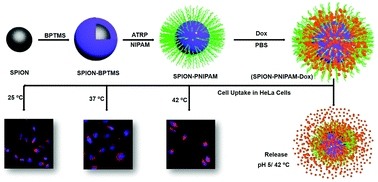Development of tailored SPION-PNIPAM nanoparticles by ATRP for dually responsive doxorubicin delivery and MR imaging†
Abstract
Biocompatible, colloidally stable and ultra-small Fe3O4 nanoparticles (SPIONs) coated with poly(N-isopropylacrylamide) (PNIPAM) were synthesized via surface-initiated ATRP (atom transfer radical polymerization) to prevent excessive aggregation of magnetic cores and interparticle crosslinking, and to provide control over polymer content. These SPION-PNIPAM nanoparticles (NPs) have a hydrodynamic size between 8 and 60 nm depending on the PNIPAM content, and hence are ultrasmall in size and have an LCST around 38 °C. They had a high drug-loading capacity reaching 9.6 wt% doxorubicin in the final composition. The Dox release studies revealed pH and temperature-dependent release, which was not reported for PNIPAM before. Release of Dox under physiological conditions was below 20%, but around 90% at 42 °C and pH 5. This dually responsive nature is very advantageous to increase the drug efficacy and reduce side-effects, simultaneously. The cytocompatability of the SPION-PNIPAM NPs and the influence of Dox delivery to cells were investigated via in vitro cell viability, apoptosis, DNA-damage and confocal microscopy studies. The NPs were shown to be highly cytocompatible and induce significant cell death due to Dox when loaded with the drug. Besides, it was seen that the polymeric content can be used as an additional factor in tuning the release kinetics. Lastly, these nanoparticles reduced the signal intensity significantly in the T2 mode, acting as a potential SPION-based contrast agent. Overall, here, we demonstrate the design of small, smart theranostic nanoparticles with high drug-loading capacity and pH-dependent temperature-sensitive release characteristics with the ability to generate contrast in MRI.



 Please wait while we load your content...
Please wait while we load your content...